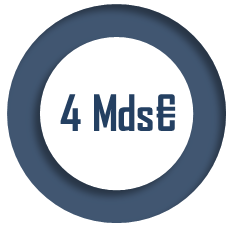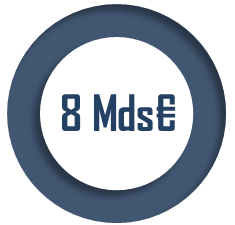C. SPAIN, A PARTNER HIGHLY MOTIVATED BY THE PROJECT
1. A solid bilateral defence and security relationship
France and Spain have long had a good bilateral relationship in defence and security . This relationship was institutionalised in 2005 by the creation of the Franco-Spanish Defence and Security Council (CFEDS - Conseil franco-espagnol de défense et de sécurité ). It has also been reflected in defence cooperation agreements. In particular, the final declaration of the Brest CFEDS in 2013 was a roadmap that laid out France and Spain's strong commitment to reinforcing the Common Security and Defence Policy (CSDP) in its strategic, operational, capability and industrial aspects as well as a convergence of operational capabilities in areas of common interest : the Mediterranean, the Sahel, the Gulf of Guinea and the Horn of Africa. Madrid also joined the European Intervention Initiative (EI2) on 25 June 2018.
On the operational side, Spain and France are cooperating in the framework of several European missions: EUTM-Somalia, EUTM-Mali, EUTM-RCA, EUNAVFOR MED IRINI. Both countries are also taking a joint initiative in support of security forces in Sahel countries as part of the G5 and through the "5+5 Defence" initiative, a multilateral forum of cooperation on both sides of the Western Mediterranean, including Morocco, Algeria, Tunisia, Libya, Mauritania, France, Italy, Malta, Spain, and Portugal.
Concerning defence industry cooperation, Spain's participation in major military programmes started in the 1980s with the Eurofighter programme and continued through multilateral cooperation, notably through its membership of OCCAr. France and Spain are participating in several defence industry cooperation programmes: Tiger, A400M, the European MALE drone, and now FCAS. In general, Spain is highly favourable to European cooperation in defence : the country is the leading contributor to EU operations, and it is now more oriented towards Europe than the United States in the matter and highly supports PESCO.
2. A precious contribution to the FCAS
After a phase that was no doubt too exclusively Franco-German, Spain's inclusion is excellent news for the FCAS .
French authorities initially gave priority to the Franco-German relationship to establish the basis for the industrial and research partnership. Spain was only able to join the project slightly after. However, Spain's political will to participate in the FCAS project is very strong : initiated by the Rajoy Government, this participation was confirmed as soon as the Sanchez Government took over in mid-2018.
The relationship between France and Germany, sometimes characterised by misunderstandings, is turning into a three-sided relationship that reflects the diversity of European cultures in defence, where France, as a central country in Europe, can no doubt act as a mediator if needed between its northern and southern neighbours.
D. A PROJECT IN COOPERATION TO SHARE COSTS AND WORK TOWARDS STRATEGIC AUTONOMY
While the political benefits of Franco-German cooperation are obvious, it is undeniably more complex to develop a project with international cooperation than it is to develop it entirely internally. The mission's interlocutors have all reiterated the multiple difficulties encountered by European programmes such as the A400M . Similarly, the precedent of France's withdrawal from the Eurofighter programme in 1985, just one and a half years after the project started and followed by the launch of the competing Rafale project, is on everyone's minds. Technologically, and not to minimise the challenge it would represent, French industry would no doubt be able to realise the entirety of the FCAS. However, it would be a very costly operation. Finally, cooperation between France, Germany and Spain will allow France to preserve its strategic autonomy while betting on a promising European strategic autonomy .
1. A project that would no doubt be too costly for a single country
Most of the mission's interlocutors took it for granted that a programme such as FCAS would be unthinkable for a single country since the development costs for such a complex programme would place it out of reach of just one nation's budget. Developing a combat aircraft is indeed more expensive today than it was in the past, let alone developing an airborne system of systems such as the FCAS.
As an example, the engine manufacturers chosen for the project (Safran and MTU) recalled during their hearing that the United States had paid more than $1 billion over the last two years to each of their two engine manufacturers (Pratt & Whitney and General Electric) to maintain their lead in hot engine parts, compared for example with the €115 million "Turenne 2" upstream study programme (PEA), awarded by the DGA to Safran to consolidate its skills. More globally, the simultaneous development of a new combat aircraft platform, a new engine, several types of drones and a specific combat cloud represents an extremely high investment that seems very burdensome for a single country .
So, while international cooperation in defence increases the amount of non-recurring expenses (research and development) slightly, it also allows the partners to share them, reducing the total expenses each country must pay. Also, given the amount of the orders, it also allows for lower unit costs (production costs can be brought down by a greater industrialisation of processes made possible by the volume of the production ordered. Finally, as the Court of Auditors highlighted in its 2018 report, 6 ( * ) savings can also be made during the operations phase by pooling support and, in particular, during the industrial phase of maintaining materials in operational condition.
Sharing costs is thus very much a necessity to be able to preserve the strategic autonomy of the air combat systems of each of the programme's member states.
Remember that the 2020 Finance Act has allocated €1.4 billion in commitment authorisations to cover the launch of the initial development activities of the demonstration programme. At the moment, the planned investment in the FCAS, equally shared by Paris and Berlin, 7 ( * ) is around €4 billion by 2025-2026 (demonstrator), and €8 billion by 2030, after which industrialisation expenses will begin. For certain analysts, the total cost of the programme is estimated at between €50 and €80 billion.
|
A contract worth |
A contract worth |
A forecasted cost of |
A forecasted cost of |
|
signed for studying the joint concept |
signed for phase 1A |
before the demonstrator in 2026 |
by 2030 |
2. A project guided by an imperative of national and European strategic autonomy
In addition to the financial aspect already covered, the convergence of interests between France, Germany and Spain in terms of combat aviation allows us to think that the three countries will preserve their strategic autonomy more effectively by cooperating together . It is also a bet on the future: that the programme will encourage a greater European strategic autonomy beyond the three countries currently participating.
a) Becoming export-competitive once again
(1) Aiming for "exportability" from the start of the programme
Cooperating to build the FCAS ensures that, at the least, the project's participants will buy this instead of competing American products, in this case the F35 and any future versions.
Additionally, as Airbus's representatives highlighted during their hearing, beyond the project's participants, "exportability" has been taken into account right from the specifications: the aircraft and its "remote carriers" must be attractive for export to reduce production costs and spread European standards.
While the three current-gen European fighters (Rafale, Eurofighter, Gripen) have seen some export success, we can nonetheless speak of a global weakening of export capability due to this division. There is no doubt that this has cost us against the F35 which, despite all the criticisms on the technical aspects, has had particularly good export success until now. Cooperatively completing an NGWS in Europe will be an asset for its exportation . In this regard, the competition with the British Tempest project would be a significant drawback (see below page ).
(2) A necessary "dis-ITAR-isation"
Strengthening strategic autonomy largely addresses the "dis-ITAR-isation" problem , i.e. the slightest exposure to ITAR (International Traffic in Arms Regulations), which allows the United States to block the export of equipment with American components. ITAR weighs on many French export projects like a sword of Damocles. In recent years, we can cite the export of SCALP missiles in Egypt or threats (carried through or not) to various export projects to India, Qatar, and the United Arab Emirates. Many pieces of equipment include American-origin electronic components, and most French aircraft in particular in some way fall under the ITAR regime. Germany and Spain also share this problem . Thus, from the start, the FCAS project integrates the need to be less dependent on ITAR in the future . 8 ( * )
b) A cooperative project encouraged by changes in the international environment
All the parties the mission heard agreed that the need for greater strategic autonomy is also the result of changes to the international environment that are impacting the three countries in the programme in the same way , encouraging them to "close ranks" to face threats from "world powers".
Brexit raises questions about the United Kingdom's future position and on the continuation of arms projects shared with this country.
Also, the change in the United States' attitude towards Europe's defence since the election of D. Trump as U.S. president has helped to move Germany to a more favourable position on European defence. This change was reflected in the Chancellor's statement upon her return from the Taormina G7 summit in May 2017 that " we Europeans must really take our destiny into our own hands because the time when we could totally rely on others has, in part, passed ". (see box above).
c) Towards European strategic autonomy?
(1) A structural project for European industry
Given its exceptional magnitude (between €50 and €80 billion according to estimates), according to Joël Barre, Chief Executive of the DGA, FCAS can structure the overall defence system at the European level and become a driver of European industry alongside many potential spill-overs into the civilian field .
According to Dirk Hoke, CEO of Airbus Defence and Space (ADS), who gave testimony to the mission in Berlin, the FCAS is a unique opportunity to rely on Europe's key strength: its great diversity that drives creativity and emulation . For him, this results in better projects for less financial investment than those made in the United States for the same type of programme.
(2) A long-term bet on Europe's strategic autonomy, which involves the issue of interoperability
Going from French, German and Spanish strategic autonomy to European strategic autonomy is undoubtedly not self-evident. Above all, it is a bet that other European countries will join the project and buy the new system of systems .
A project with three partners is already highly complex. As Dassault Aviation's CEO highlighted during his hearing, this three-partner core must be strong first for it to be reasonable to consider expanding it to other European countries.
The future link between the FCAS project and the European Union can go through the new European defence instruments, such as : Permanent Structured Cooperation (PESCO), the European Defence Industrial Development Programme (EDIDP), and the European Defence Fund (EDF):
• Concerning PESCO , projects have been selected in three stages since 2017, the last selection having taken place in November 2019, bringing the total number of these projects to 47 . One of these projects is called "EU Collaborative Warfare Capabilities (ECoWAR)" and brings together France, Belgium, Spain, Hungary, Romania, Spain and Sweden . This project's definition centred around collaborative combat and connected platforms concerns all environments, not just the air. It is a forum where countries' representatives can identify needs for capabilities and future doctrines of use as well as the bricks needed to build collaborative combat.
The ECoWar programme has a certain significance to the perspectives for building interoperability with France's European partners who chose the F35, interoperability that can make up for the lack of the native interoperability of the American aircraft . Several countries, such as Belgium and Italy, who have seen that they cannot make the F35 interoperable with their other combat aircraft, are turning to this programme. More globally, the ECoWar project's goal is to review all NATO (FMN) 9 ( * ) and European (ESSOR) 10 ( * ) interoperability works to further a European vision of interoperability . Thus, other European countries could come to the FCAS programme through this issue of interoperability .
• Concerning EDIDP , which includes €500 million of funding with two tranches of €200 million for calls for bids in 2019 and 2020, France is also carrying out cooperation projects in air combat (equipment, training resources) to build networks with manufacturers in other European countries on these issues on the margins of the FCAS .
• Finally, and above all, a series of meetings will be held through the end of 2020 to reach a structure for the EDF . The issue of the next-generation combat aircraft will necessarily be a part of the discussions, as most likely will be the way in which the EDF could have "points of adherence" with the FCAS, in one way or another. Once again, the goal will be to have a wide-ranging cooperative approach to the bricks of the system beyond just the FCAS programme's initial members.
In total, the challenge is to find convergences between multilateral approaches and a Community approach. As part of these Community instruments, the European Commission will probably also want to move forward on issues of defence, including collaborative combat, specifically to give them a more Community aspect. It will then be necessary to work to maintain FCAS's solidity and consistency while surfing on the momentum from the Commission. Such a situation is already being trialled with the Euromale drone, supported by the EDIDP to the tune of €90 million. 11 ( * )
d) FCAS and NATO
For now, NATO is not discussing the issue of the FCAS directly. However, the organisation is drawing up and standardising rules of interoperability (STANAGs related to data links) that apply to the air combat cloud of its member countries to which the FCAS's data links must be able to integrate.
NATO is also developing a replacement programme for the AWACS entitled " Alliance Future Surveillance and Control " (AFSC) with €120 million of funding from allies as a control and communication system. This will not be a single platform but a system of systems that will intersect with the FCAS architecture in that future platforms will need to be able to connect to it. The risk would be that this future NATO system will be directly derived from American standards. Thus, it is essential to take this aspect into account from the start of the FCAS programme.
Furthermore, the FCAS is considered within NATO as an opportunity to modernise member countries' aircraft fleets. A review will have to be carried out on how the NATO missions taken over by Germany and France will be carried out with the FCAS and what added value they will bring to the situation at hand: deep strikes, air superiority, etc.
* 6 European cooperation in arms, a necessary reinforcement, subject to demanding conditions, 2018.
* 7 The amount of funding provided by Spain is not yet set, but Spain intends to contribute the same amounts as its partners
* 8 We should note that, for example, the MICA missile, the next generation of MBDA, is already designed to exclude any ITAR components.
* 9 Federated Mission Networking
* 10 European Secure Software defined Radio
* 11 in spite of a certain reluctance from countries who are not members of the programme.











